Organizational Change: A Case for Lakeland Wonders
VerifiedAdded on 2022/11/09
|14
|3808
|108
AI Summary
This article discusses the nature and reasons for organizational change in Lakeland Wonders, appropriateness of Cheryl Hailstrom management change approaches, limitations of her organizational change techniques, need for change in Lakeland Wonders, and organizational culture in Lakeland Wonders case.
Contribute Materials
Your contribution can guide someone’s learning journey. Share your
documents today.
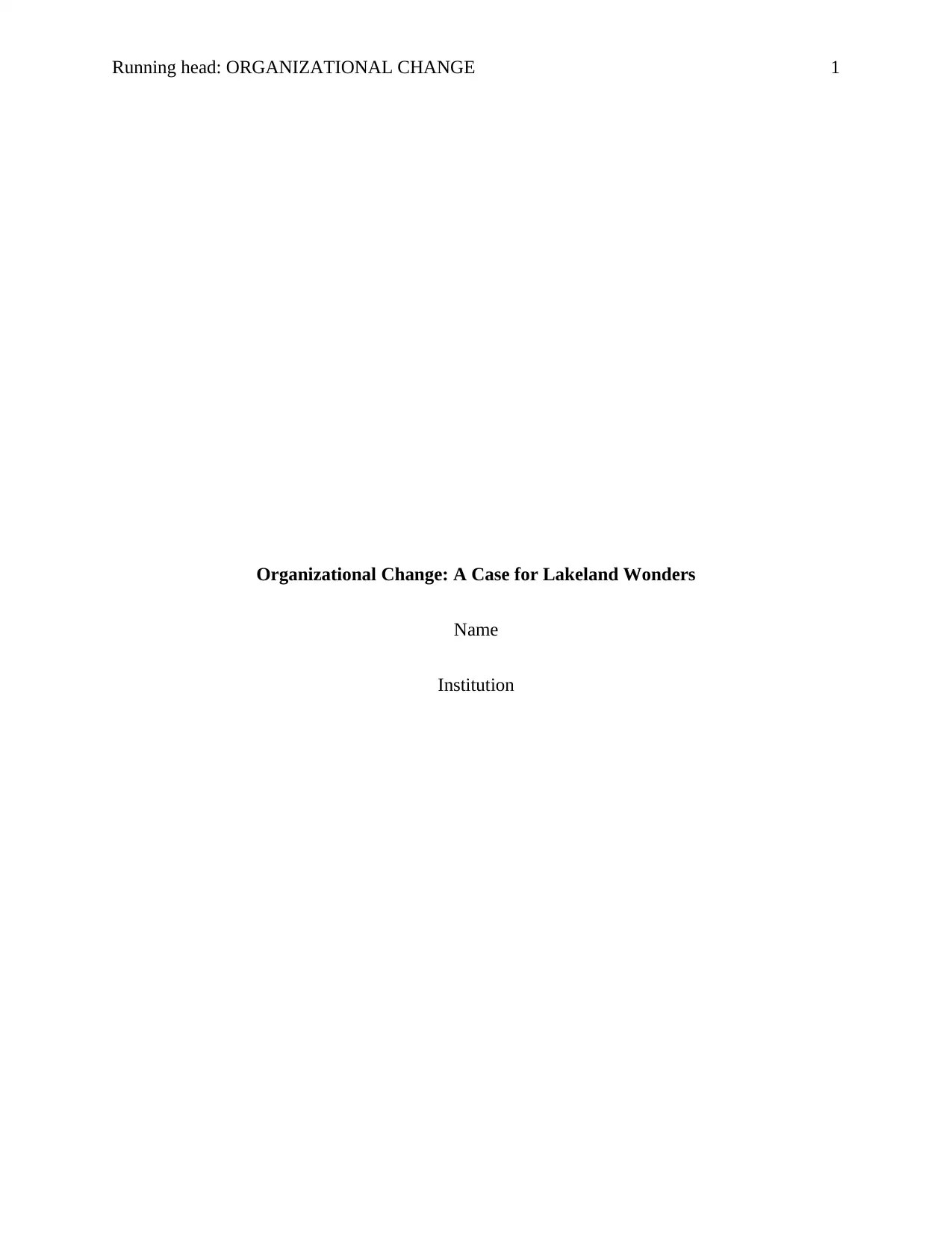
Running head: ORGANIZATIONAL CHANGE 1
Organizational Change: A Case for Lakeland Wonders
Name
Institution
Organizational Change: A Case for Lakeland Wonders
Name
Institution
Secure Best Marks with AI Grader
Need help grading? Try our AI Grader for instant feedback on your assignments.
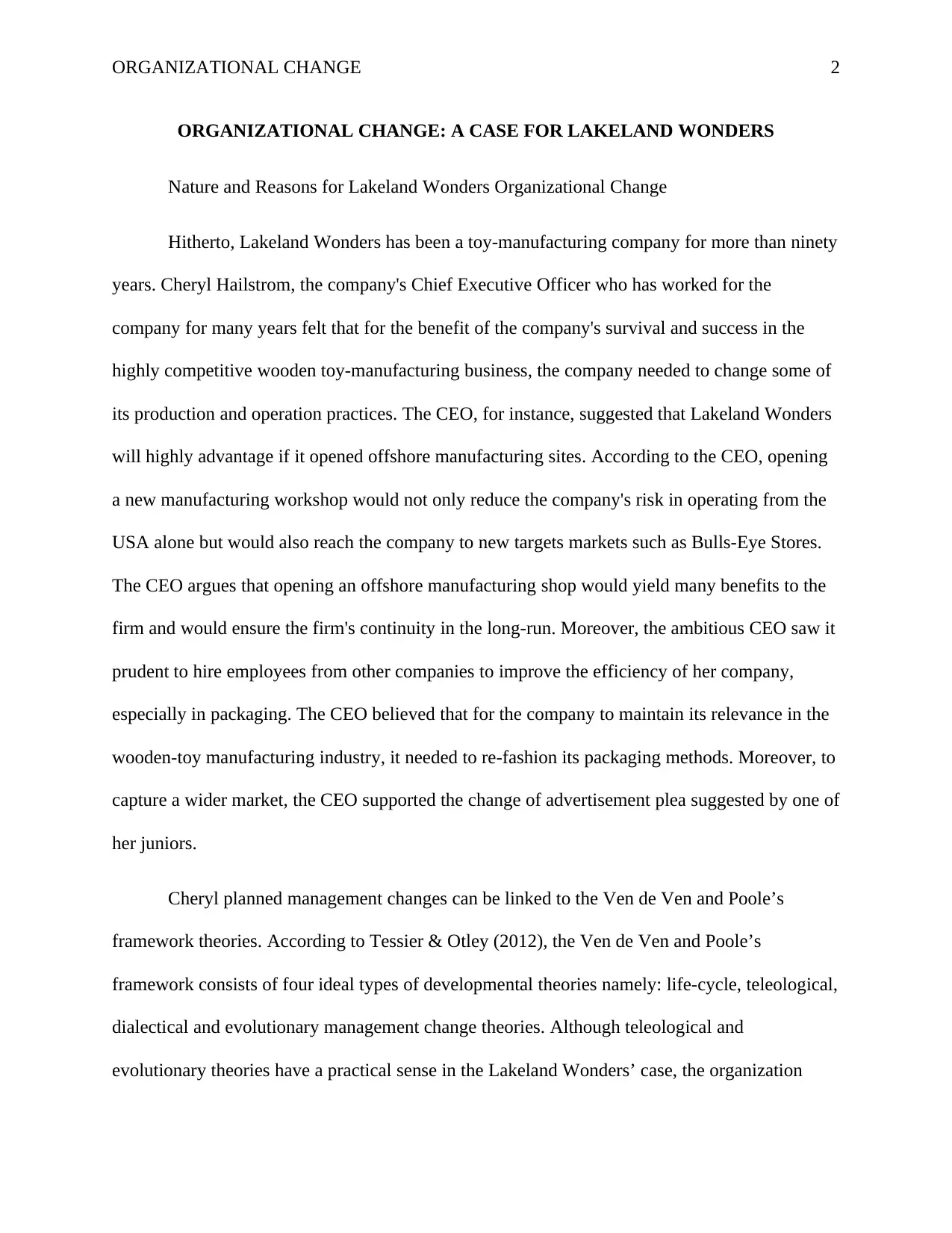
ORGANIZATIONAL CHANGE 2
ORGANIZATIONAL CHANGE: A CASE FOR LAKELAND WONDERS
Nature and Reasons for Lakeland Wonders Organizational Change
Hitherto, Lakeland Wonders has been a toy-manufacturing company for more than ninety
years. Cheryl Hailstrom, the company's Chief Executive Officer who has worked for the
company for many years felt that for the benefit of the company's survival and success in the
highly competitive wooden toy-manufacturing business, the company needed to change some of
its production and operation practices. The CEO, for instance, suggested that Lakeland Wonders
will highly advantage if it opened offshore manufacturing sites. According to the CEO, opening
a new manufacturing workshop would not only reduce the company's risk in operating from the
USA alone but would also reach the company to new targets markets such as Bulls-Eye Stores.
The CEO argues that opening an offshore manufacturing shop would yield many benefits to the
firm and would ensure the firm's continuity in the long-run. Moreover, the ambitious CEO saw it
prudent to hire employees from other companies to improve the efficiency of her company,
especially in packaging. The CEO believed that for the company to maintain its relevance in the
wooden-toy manufacturing industry, it needed to re-fashion its packaging methods. Moreover, to
capture a wider market, the CEO supported the change of advertisement plea suggested by one of
her juniors.
Cheryl planned management changes can be linked to the Ven de Ven and Poole’s
framework theories. According to Tessier & Otley (2012), the Ven de Ven and Poole’s
framework consists of four ideal types of developmental theories namely: life-cycle, teleological,
dialectical and evolutionary management change theories. Although teleological and
evolutionary theories have a practical sense in the Lakeland Wonders’ case, the organization
ORGANIZATIONAL CHANGE: A CASE FOR LAKELAND WONDERS
Nature and Reasons for Lakeland Wonders Organizational Change
Hitherto, Lakeland Wonders has been a toy-manufacturing company for more than ninety
years. Cheryl Hailstrom, the company's Chief Executive Officer who has worked for the
company for many years felt that for the benefit of the company's survival and success in the
highly competitive wooden toy-manufacturing business, the company needed to change some of
its production and operation practices. The CEO, for instance, suggested that Lakeland Wonders
will highly advantage if it opened offshore manufacturing sites. According to the CEO, opening
a new manufacturing workshop would not only reduce the company's risk in operating from the
USA alone but would also reach the company to new targets markets such as Bulls-Eye Stores.
The CEO argues that opening an offshore manufacturing shop would yield many benefits to the
firm and would ensure the firm's continuity in the long-run. Moreover, the ambitious CEO saw it
prudent to hire employees from other companies to improve the efficiency of her company,
especially in packaging. The CEO believed that for the company to maintain its relevance in the
wooden-toy manufacturing industry, it needed to re-fashion its packaging methods. Moreover, to
capture a wider market, the CEO supported the change of advertisement plea suggested by one of
her juniors.
Cheryl planned management changes can be linked to the Ven de Ven and Poole’s
framework theories. According to Tessier & Otley (2012), the Ven de Ven and Poole’s
framework consists of four ideal types of developmental theories namely: life-cycle, teleological,
dialectical and evolutionary management change theories. Although teleological and
evolutionary theories have a practical sense in the Lakeland Wonders’ case, the organization
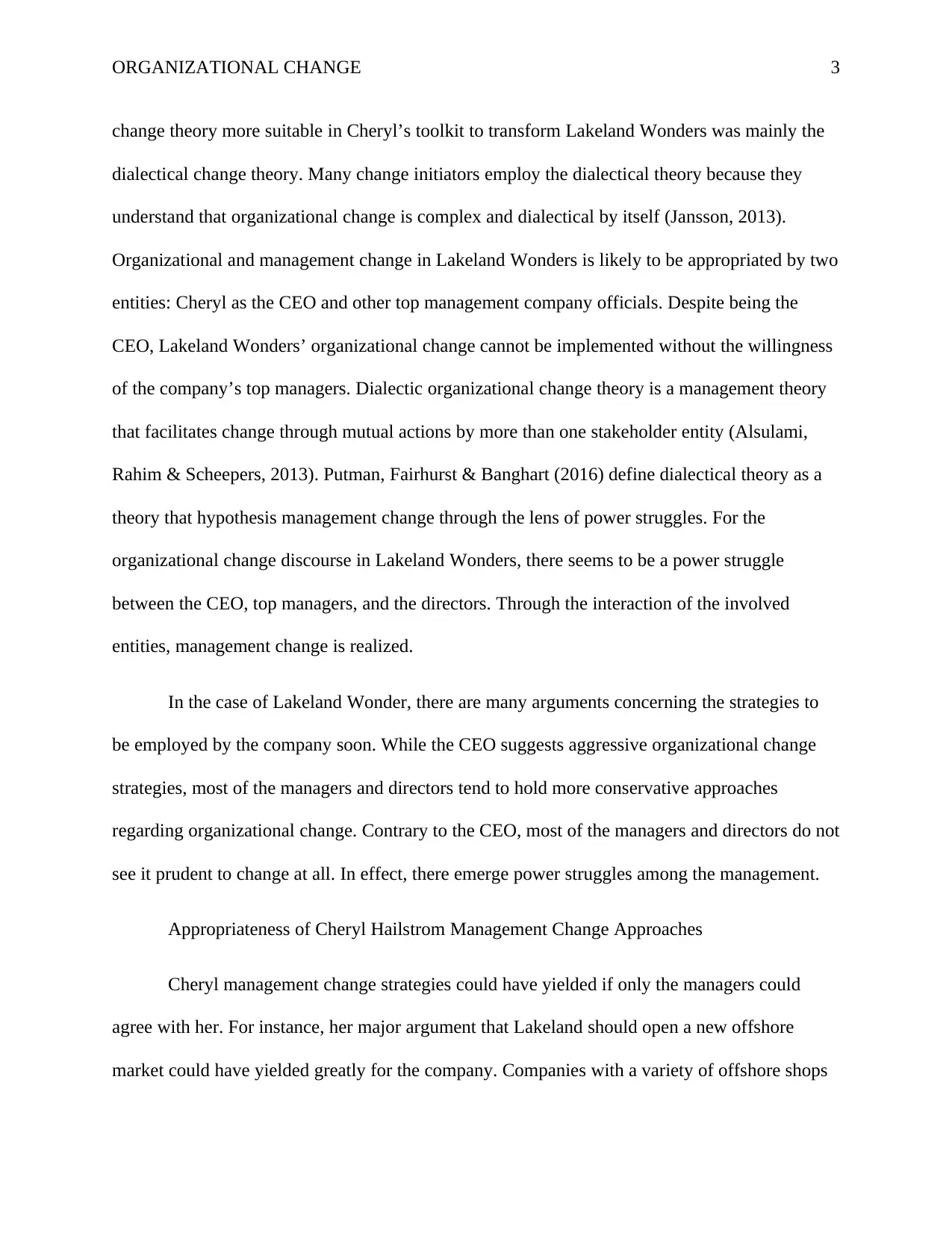
ORGANIZATIONAL CHANGE 3
change theory more suitable in Cheryl’s toolkit to transform Lakeland Wonders was mainly the
dialectical change theory. Many change initiators employ the dialectical theory because they
understand that organizational change is complex and dialectical by itself (Jansson, 2013).
Organizational and management change in Lakeland Wonders is likely to be appropriated by two
entities: Cheryl as the CEO and other top management company officials. Despite being the
CEO, Lakeland Wonders’ organizational change cannot be implemented without the willingness
of the company’s top managers. Dialectic organizational change theory is a management theory
that facilitates change through mutual actions by more than one stakeholder entity (Alsulami,
Rahim & Scheepers, 2013). Putman, Fairhurst & Banghart (2016) define dialectical theory as a
theory that hypothesis management change through the lens of power struggles. For the
organizational change discourse in Lakeland Wonders, there seems to be a power struggle
between the CEO, top managers, and the directors. Through the interaction of the involved
entities, management change is realized.
In the case of Lakeland Wonder, there are many arguments concerning the strategies to
be employed by the company soon. While the CEO suggests aggressive organizational change
strategies, most of the managers and directors tend to hold more conservative approaches
regarding organizational change. Contrary to the CEO, most of the managers and directors do not
see it prudent to change at all. In effect, there emerge power struggles among the management.
Appropriateness of Cheryl Hailstrom Management Change Approaches
Cheryl management change strategies could have yielded if only the managers could
agree with her. For instance, her major argument that Lakeland should open a new offshore
market could have yielded greatly for the company. Companies with a variety of offshore shops
change theory more suitable in Cheryl’s toolkit to transform Lakeland Wonders was mainly the
dialectical change theory. Many change initiators employ the dialectical theory because they
understand that organizational change is complex and dialectical by itself (Jansson, 2013).
Organizational and management change in Lakeland Wonders is likely to be appropriated by two
entities: Cheryl as the CEO and other top management company officials. Despite being the
CEO, Lakeland Wonders’ organizational change cannot be implemented without the willingness
of the company’s top managers. Dialectic organizational change theory is a management theory
that facilitates change through mutual actions by more than one stakeholder entity (Alsulami,
Rahim & Scheepers, 2013). Putman, Fairhurst & Banghart (2016) define dialectical theory as a
theory that hypothesis management change through the lens of power struggles. For the
organizational change discourse in Lakeland Wonders, there seems to be a power struggle
between the CEO, top managers, and the directors. Through the interaction of the involved
entities, management change is realized.
In the case of Lakeland Wonder, there are many arguments concerning the strategies to
be employed by the company soon. While the CEO suggests aggressive organizational change
strategies, most of the managers and directors tend to hold more conservative approaches
regarding organizational change. Contrary to the CEO, most of the managers and directors do not
see it prudent to change at all. In effect, there emerge power struggles among the management.
Appropriateness of Cheryl Hailstrom Management Change Approaches
Cheryl management change strategies could have yielded if only the managers could
agree with her. For instance, her major argument that Lakeland should open a new offshore
market could have yielded greatly for the company. Companies with a variety of offshore shops
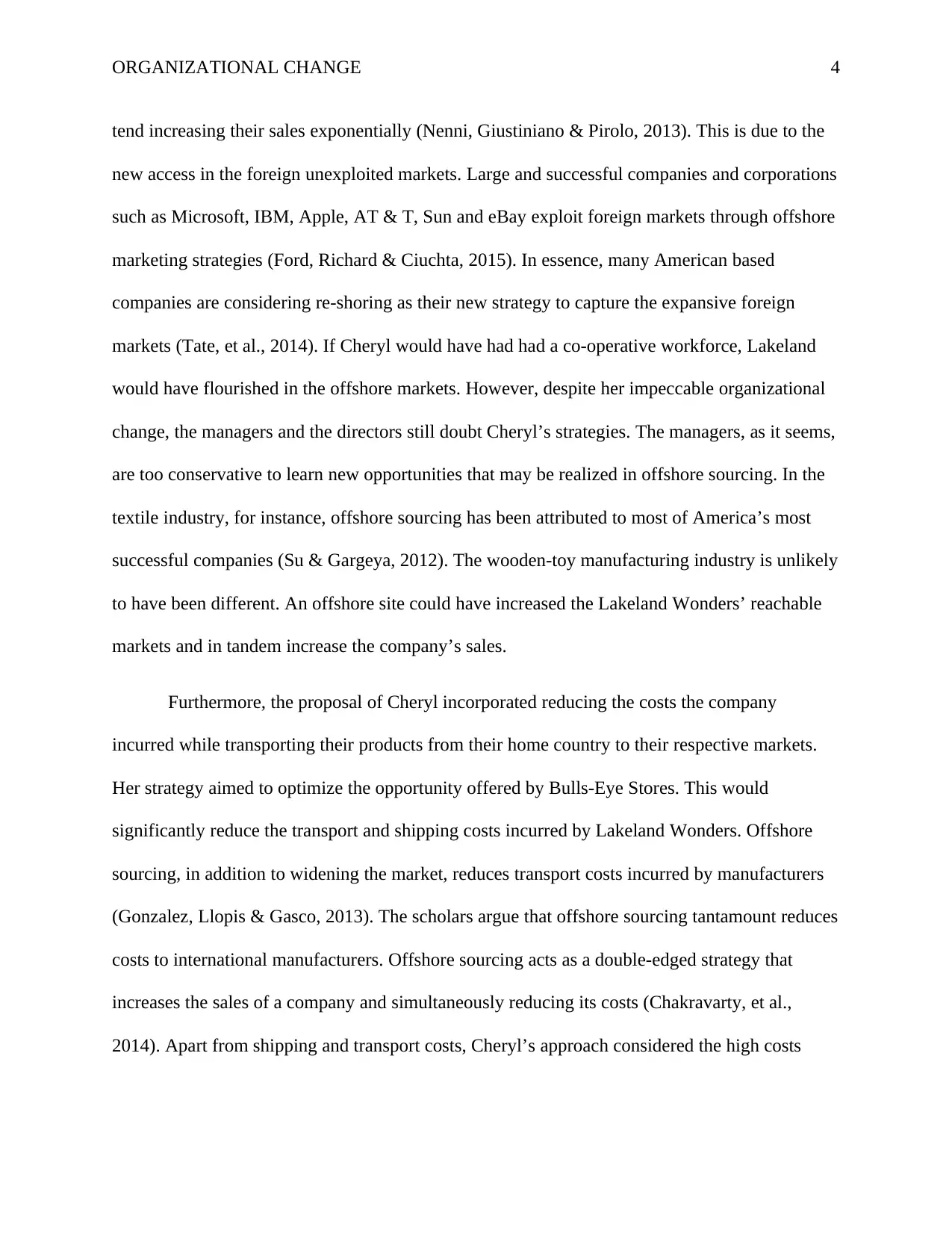
ORGANIZATIONAL CHANGE 4
tend increasing their sales exponentially (Nenni, Giustiniano & Pirolo, 2013). This is due to the
new access in the foreign unexploited markets. Large and successful companies and corporations
such as Microsoft, IBM, Apple, AT & T, Sun and eBay exploit foreign markets through offshore
marketing strategies (Ford, Richard & Ciuchta, 2015). In essence, many American based
companies are considering re-shoring as their new strategy to capture the expansive foreign
markets (Tate, et al., 2014). If Cheryl would have had had a co-operative workforce, Lakeland
would have flourished in the offshore markets. However, despite her impeccable organizational
change, the managers and the directors still doubt Cheryl’s strategies. The managers, as it seems,
are too conservative to learn new opportunities that may be realized in offshore sourcing. In the
textile industry, for instance, offshore sourcing has been attributed to most of America’s most
successful companies (Su & Gargeya, 2012). The wooden-toy manufacturing industry is unlikely
to have been different. An offshore site could have increased the Lakeland Wonders’ reachable
markets and in tandem increase the company’s sales.
Furthermore, the proposal of Cheryl incorporated reducing the costs the company
incurred while transporting their products from their home country to their respective markets.
Her strategy aimed to optimize the opportunity offered by Bulls-Eye Stores. This would
significantly reduce the transport and shipping costs incurred by Lakeland Wonders. Offshore
sourcing, in addition to widening the market, reduces transport costs incurred by manufacturers
(Gonzalez, Llopis & Gasco, 2013). The scholars argue that offshore sourcing tantamount reduces
costs to international manufacturers. Offshore sourcing acts as a double-edged strategy that
increases the sales of a company and simultaneously reducing its costs (Chakravarty, et al.,
2014). Apart from shipping and transport costs, Cheryl’s approach considered the high costs
tend increasing their sales exponentially (Nenni, Giustiniano & Pirolo, 2013). This is due to the
new access in the foreign unexploited markets. Large and successful companies and corporations
such as Microsoft, IBM, Apple, AT & T, Sun and eBay exploit foreign markets through offshore
marketing strategies (Ford, Richard & Ciuchta, 2015). In essence, many American based
companies are considering re-shoring as their new strategy to capture the expansive foreign
markets (Tate, et al., 2014). If Cheryl would have had had a co-operative workforce, Lakeland
would have flourished in the offshore markets. However, despite her impeccable organizational
change, the managers and the directors still doubt Cheryl’s strategies. The managers, as it seems,
are too conservative to learn new opportunities that may be realized in offshore sourcing. In the
textile industry, for instance, offshore sourcing has been attributed to most of America’s most
successful companies (Su & Gargeya, 2012). The wooden-toy manufacturing industry is unlikely
to have been different. An offshore site could have increased the Lakeland Wonders’ reachable
markets and in tandem increase the company’s sales.
Furthermore, the proposal of Cheryl incorporated reducing the costs the company
incurred while transporting their products from their home country to their respective markets.
Her strategy aimed to optimize the opportunity offered by Bulls-Eye Stores. This would
significantly reduce the transport and shipping costs incurred by Lakeland Wonders. Offshore
sourcing, in addition to widening the market, reduces transport costs incurred by manufacturers
(Gonzalez, Llopis & Gasco, 2013). The scholars argue that offshore sourcing tantamount reduces
costs to international manufacturers. Offshore sourcing acts as a double-edged strategy that
increases the sales of a company and simultaneously reducing its costs (Chakravarty, et al.,
2014). Apart from shipping and transport costs, Cheryl’s approach considered the high costs
Secure Best Marks with AI Grader
Need help grading? Try our AI Grader for instant feedback on your assignments.
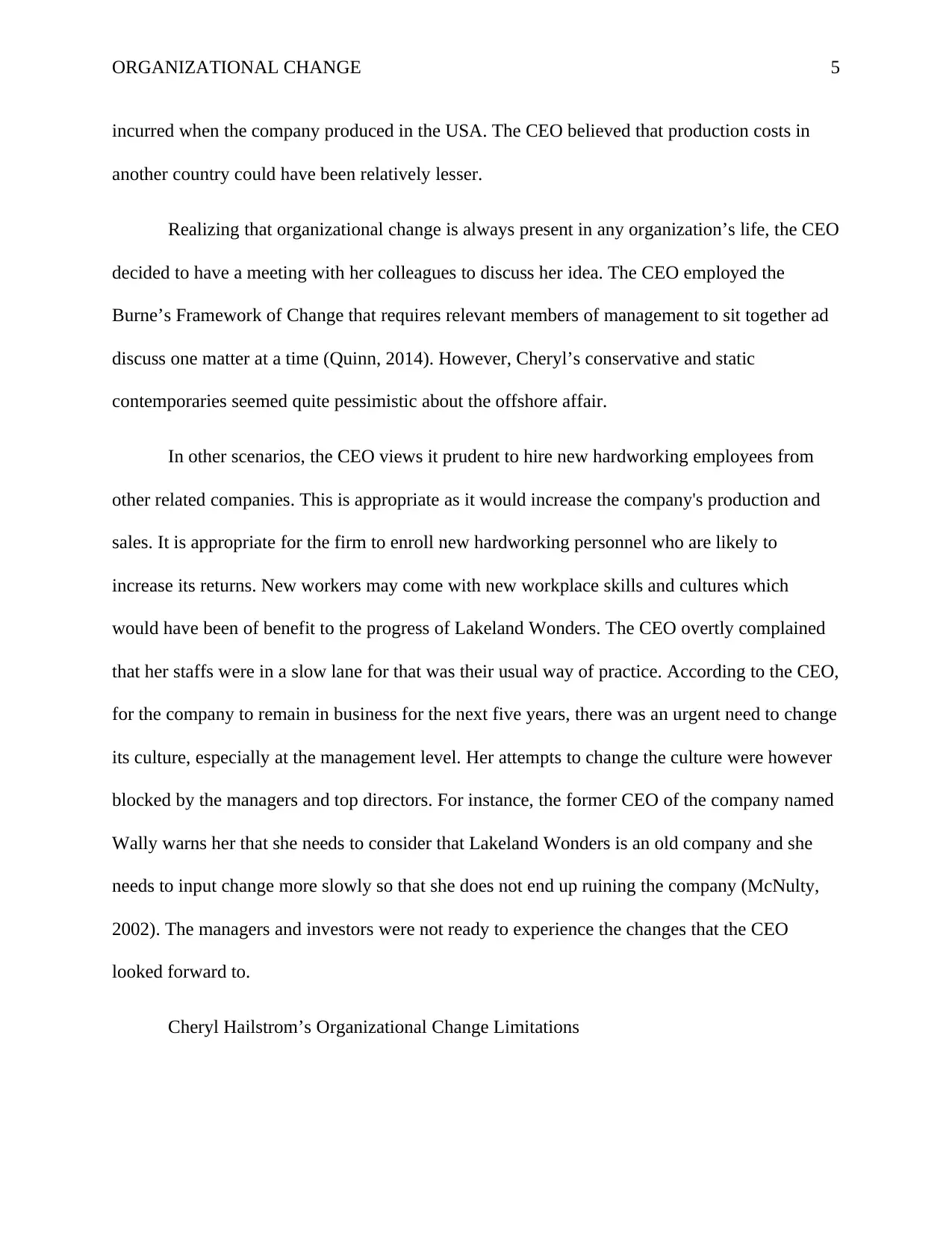
ORGANIZATIONAL CHANGE 5
incurred when the company produced in the USA. The CEO believed that production costs in
another country could have been relatively lesser.
Realizing that organizational change is always present in any organization’s life, the CEO
decided to have a meeting with her colleagues to discuss her idea. The CEO employed the
Burne’s Framework of Change that requires relevant members of management to sit together ad
discuss one matter at a time (Quinn, 2014). However, Cheryl’s conservative and static
contemporaries seemed quite pessimistic about the offshore affair.
In other scenarios, the CEO views it prudent to hire new hardworking employees from
other related companies. This is appropriate as it would increase the company's production and
sales. It is appropriate for the firm to enroll new hardworking personnel who are likely to
increase its returns. New workers may come with new workplace skills and cultures which
would have been of benefit to the progress of Lakeland Wonders. The CEO overtly complained
that her staffs were in a slow lane for that was their usual way of practice. According to the CEO,
for the company to remain in business for the next five years, there was an urgent need to change
its culture, especially at the management level. Her attempts to change the culture were however
blocked by the managers and top directors. For instance, the former CEO of the company named
Wally warns her that she needs to consider that Lakeland Wonders is an old company and she
needs to input change more slowly so that she does not end up ruining the company (McNulty,
2002). The managers and investors were not ready to experience the changes that the CEO
looked forward to.
Cheryl Hailstrom’s Organizational Change Limitations
incurred when the company produced in the USA. The CEO believed that production costs in
another country could have been relatively lesser.
Realizing that organizational change is always present in any organization’s life, the CEO
decided to have a meeting with her colleagues to discuss her idea. The CEO employed the
Burne’s Framework of Change that requires relevant members of management to sit together ad
discuss one matter at a time (Quinn, 2014). However, Cheryl’s conservative and static
contemporaries seemed quite pessimistic about the offshore affair.
In other scenarios, the CEO views it prudent to hire new hardworking employees from
other related companies. This is appropriate as it would increase the company's production and
sales. It is appropriate for the firm to enroll new hardworking personnel who are likely to
increase its returns. New workers may come with new workplace skills and cultures which
would have been of benefit to the progress of Lakeland Wonders. The CEO overtly complained
that her staffs were in a slow lane for that was their usual way of practice. According to the CEO,
for the company to remain in business for the next five years, there was an urgent need to change
its culture, especially at the management level. Her attempts to change the culture were however
blocked by the managers and top directors. For instance, the former CEO of the company named
Wally warns her that she needs to consider that Lakeland Wonders is an old company and she
needs to input change more slowly so that she does not end up ruining the company (McNulty,
2002). The managers and investors were not ready to experience the changes that the CEO
looked forward to.
Cheryl Hailstrom’s Organizational Change Limitations
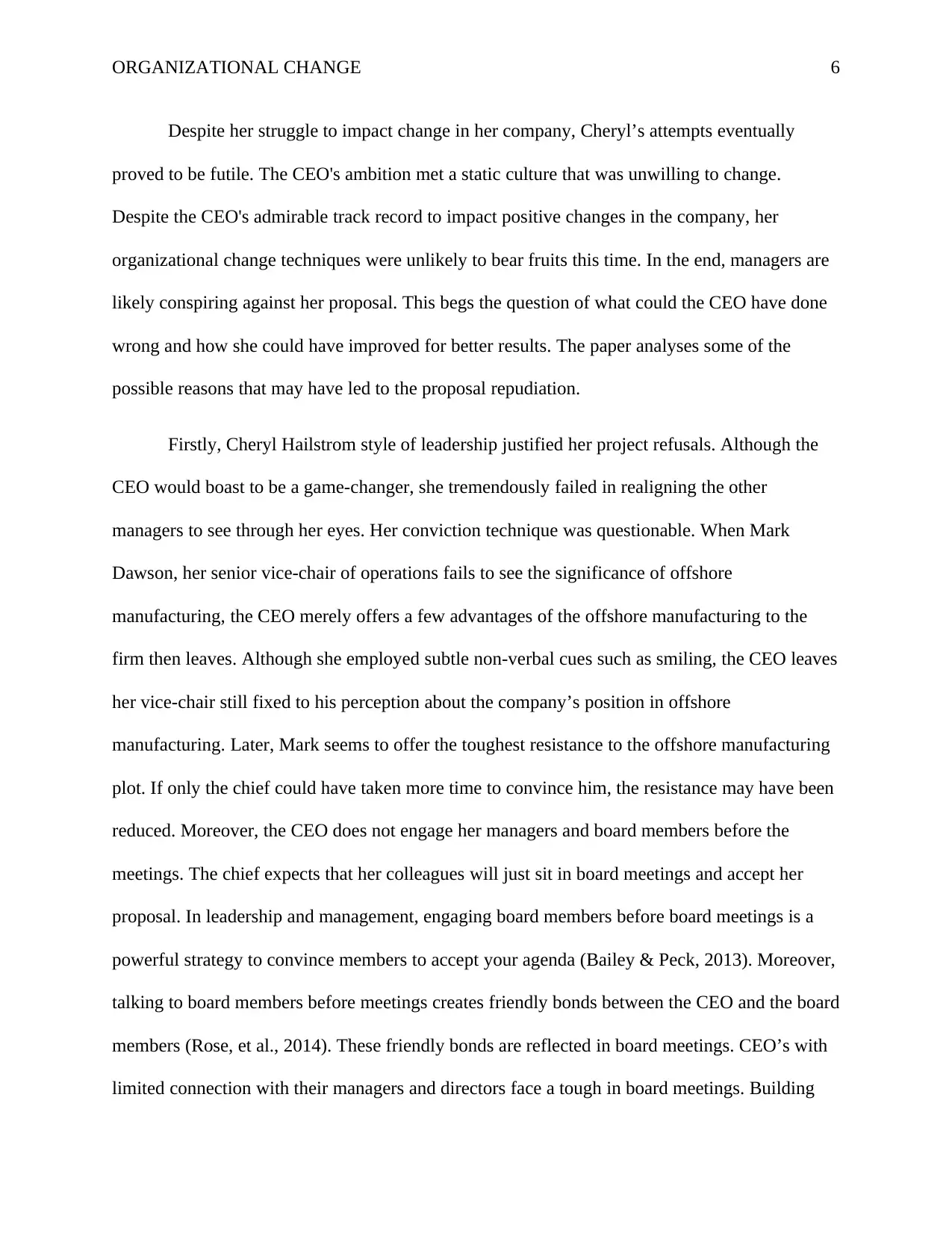
ORGANIZATIONAL CHANGE 6
Despite her struggle to impact change in her company, Cheryl’s attempts eventually
proved to be futile. The CEO's ambition met a static culture that was unwilling to change.
Despite the CEO's admirable track record to impact positive changes in the company, her
organizational change techniques were unlikely to bear fruits this time. In the end, managers are
likely conspiring against her proposal. This begs the question of what could the CEO have done
wrong and how she could have improved for better results. The paper analyses some of the
possible reasons that may have led to the proposal repudiation.
Firstly, Cheryl Hailstrom style of leadership justified her project refusals. Although the
CEO would boast to be a game-changer, she tremendously failed in realigning the other
managers to see through her eyes. Her conviction technique was questionable. When Mark
Dawson, her senior vice-chair of operations fails to see the significance of offshore
manufacturing, the CEO merely offers a few advantages of the offshore manufacturing to the
firm then leaves. Although she employed subtle non-verbal cues such as smiling, the CEO leaves
her vice-chair still fixed to his perception about the company’s position in offshore
manufacturing. Later, Mark seems to offer the toughest resistance to the offshore manufacturing
plot. If only the chief could have taken more time to convince him, the resistance may have been
reduced. Moreover, the CEO does not engage her managers and board members before the
meetings. The chief expects that her colleagues will just sit in board meetings and accept her
proposal. In leadership and management, engaging board members before board meetings is a
powerful strategy to convince members to accept your agenda (Bailey & Peck, 2013). Moreover,
talking to board members before meetings creates friendly bonds between the CEO and the board
members (Rose, et al., 2014). These friendly bonds are reflected in board meetings. CEO’s with
limited connection with their managers and directors face a tough in board meetings. Building
Despite her struggle to impact change in her company, Cheryl’s attempts eventually
proved to be futile. The CEO's ambition met a static culture that was unwilling to change.
Despite the CEO's admirable track record to impact positive changes in the company, her
organizational change techniques were unlikely to bear fruits this time. In the end, managers are
likely conspiring against her proposal. This begs the question of what could the CEO have done
wrong and how she could have improved for better results. The paper analyses some of the
possible reasons that may have led to the proposal repudiation.
Firstly, Cheryl Hailstrom style of leadership justified her project refusals. Although the
CEO would boast to be a game-changer, she tremendously failed in realigning the other
managers to see through her eyes. Her conviction technique was questionable. When Mark
Dawson, her senior vice-chair of operations fails to see the significance of offshore
manufacturing, the CEO merely offers a few advantages of the offshore manufacturing to the
firm then leaves. Although she employed subtle non-verbal cues such as smiling, the CEO leaves
her vice-chair still fixed to his perception about the company’s position in offshore
manufacturing. Later, Mark seems to offer the toughest resistance to the offshore manufacturing
plot. If only the chief could have taken more time to convince him, the resistance may have been
reduced. Moreover, the CEO does not engage her managers and board members before the
meetings. The chief expects that her colleagues will just sit in board meetings and accept her
proposal. In leadership and management, engaging board members before board meetings is a
powerful strategy to convince members to accept your agenda (Bailey & Peck, 2013). Moreover,
talking to board members before meetings creates friendly bonds between the CEO and the board
members (Rose, et al., 2014). These friendly bonds are reflected in board meetings. CEO’s with
limited connection with their managers and directors face a tough in board meetings. Building
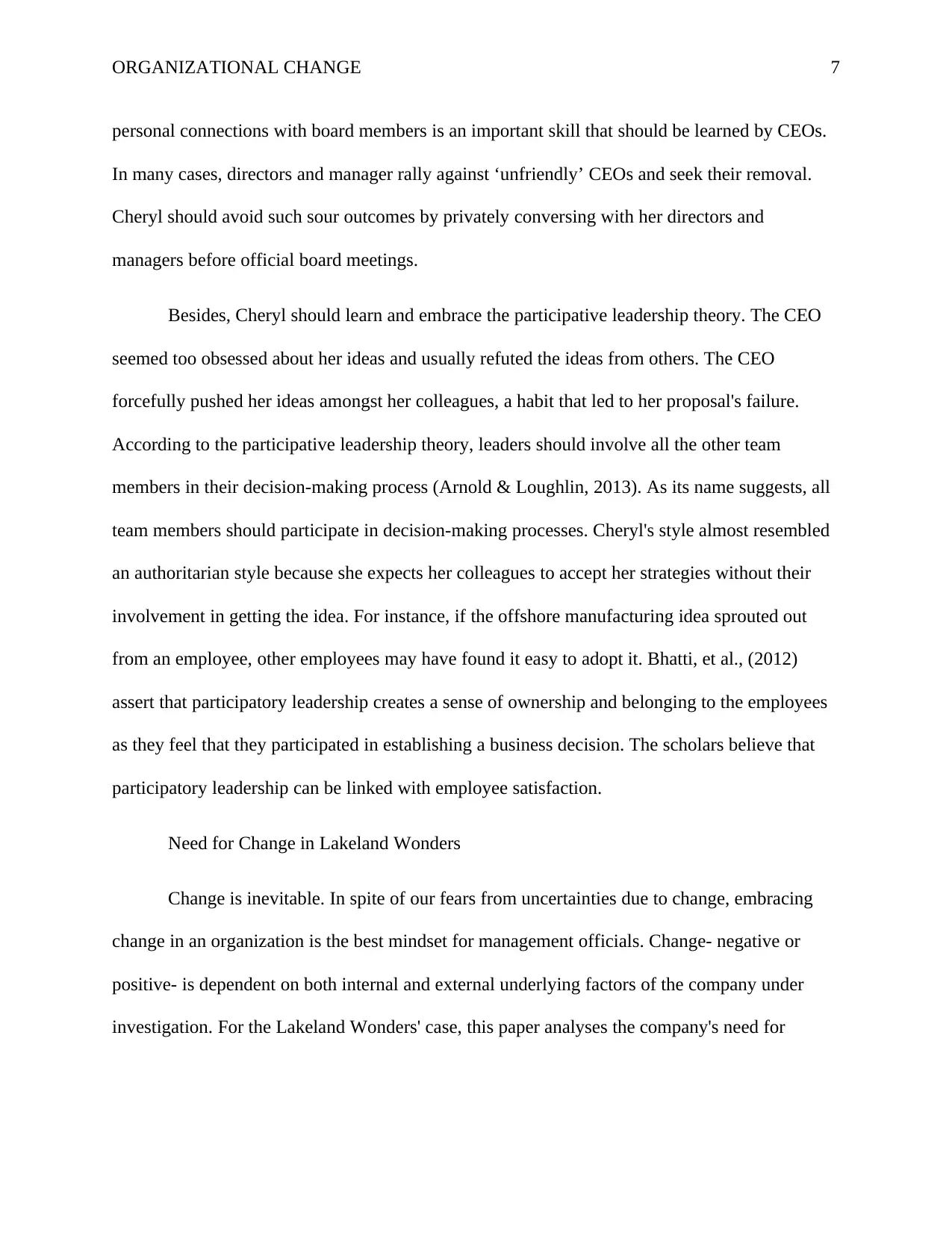
ORGANIZATIONAL CHANGE 7
personal connections with board members is an important skill that should be learned by CEOs.
In many cases, directors and manager rally against ‘unfriendly’ CEOs and seek their removal.
Cheryl should avoid such sour outcomes by privately conversing with her directors and
managers before official board meetings.
Besides, Cheryl should learn and embrace the participative leadership theory. The CEO
seemed too obsessed about her ideas and usually refuted the ideas from others. The CEO
forcefully pushed her ideas amongst her colleagues, a habit that led to her proposal's failure.
According to the participative leadership theory, leaders should involve all the other team
members in their decision-making process (Arnold & Loughlin, 2013). As its name suggests, all
team members should participate in decision-making processes. Cheryl's style almost resembled
an authoritarian style because she expects her colleagues to accept her strategies without their
involvement in getting the idea. For instance, if the offshore manufacturing idea sprouted out
from an employee, other employees may have found it easy to adopt it. Bhatti, et al., (2012)
assert that participatory leadership creates a sense of ownership and belonging to the employees
as they feel that they participated in establishing a business decision. The scholars believe that
participatory leadership can be linked with employee satisfaction.
Need for Change in Lakeland Wonders
Change is inevitable. In spite of our fears from uncertainties due to change, embracing
change in an organization is the best mindset for management officials. Change- negative or
positive- is dependent on both internal and external underlying factors of the company under
investigation. For the Lakeland Wonders' case, this paper analyses the company's need for
personal connections with board members is an important skill that should be learned by CEOs.
In many cases, directors and manager rally against ‘unfriendly’ CEOs and seek their removal.
Cheryl should avoid such sour outcomes by privately conversing with her directors and
managers before official board meetings.
Besides, Cheryl should learn and embrace the participative leadership theory. The CEO
seemed too obsessed about her ideas and usually refuted the ideas from others. The CEO
forcefully pushed her ideas amongst her colleagues, a habit that led to her proposal's failure.
According to the participative leadership theory, leaders should involve all the other team
members in their decision-making process (Arnold & Loughlin, 2013). As its name suggests, all
team members should participate in decision-making processes. Cheryl's style almost resembled
an authoritarian style because she expects her colleagues to accept her strategies without their
involvement in getting the idea. For instance, if the offshore manufacturing idea sprouted out
from an employee, other employees may have found it easy to adopt it. Bhatti, et al., (2012)
assert that participatory leadership creates a sense of ownership and belonging to the employees
as they feel that they participated in establishing a business decision. The scholars believe that
participatory leadership can be linked with employee satisfaction.
Need for Change in Lakeland Wonders
Change is inevitable. In spite of our fears from uncertainties due to change, embracing
change in an organization is the best mindset for management officials. Change- negative or
positive- is dependent on both internal and external underlying factors of the company under
investigation. For the Lakeland Wonders' case, this paper analyses the company's need for
Paraphrase This Document
Need a fresh take? Get an instant paraphrase of this document with our AI Paraphraser
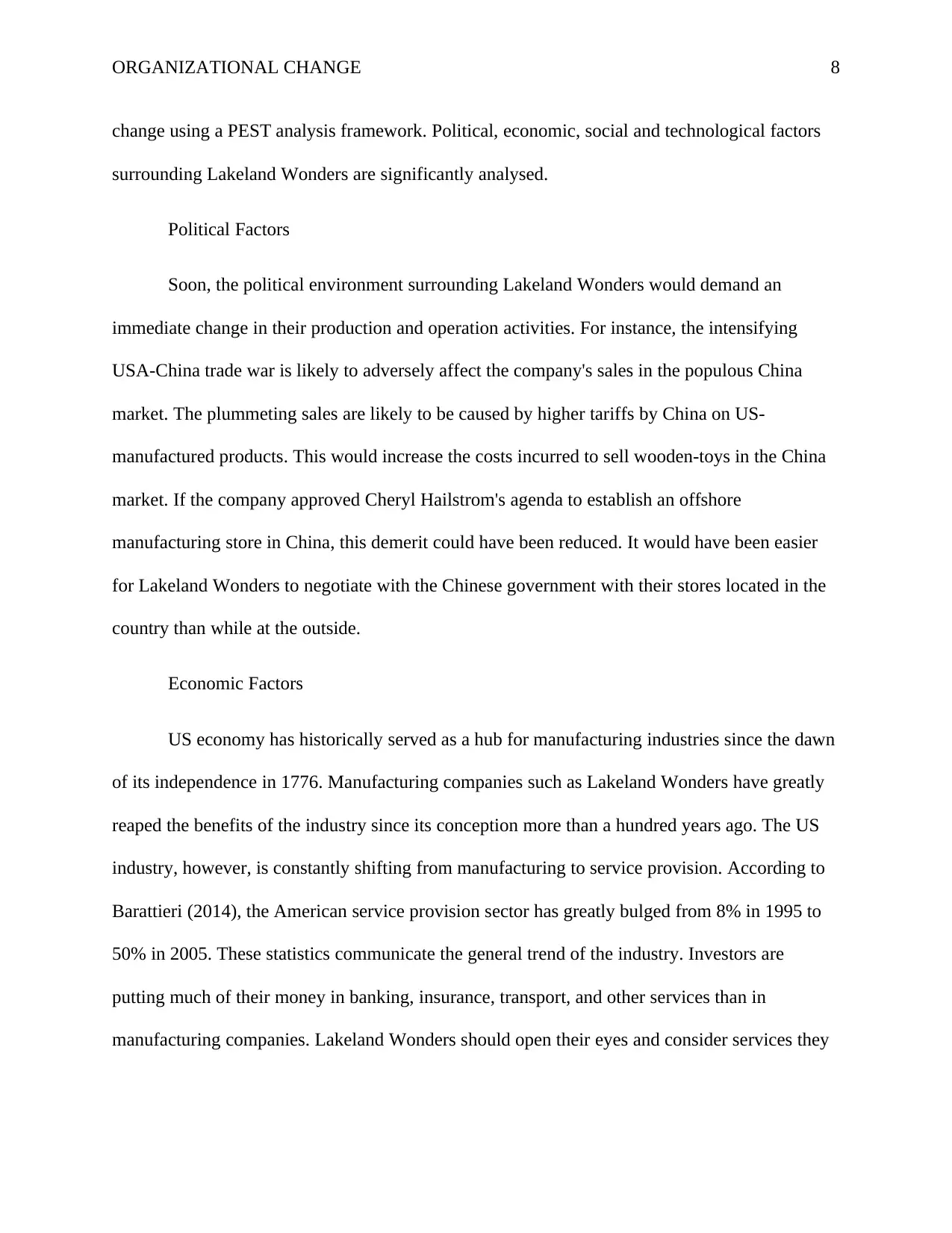
ORGANIZATIONAL CHANGE 8
change using a PEST analysis framework. Political, economic, social and technological factors
surrounding Lakeland Wonders are significantly analysed.
Political Factors
Soon, the political environment surrounding Lakeland Wonders would demand an
immediate change in their production and operation activities. For instance, the intensifying
USA-China trade war is likely to adversely affect the company's sales in the populous China
market. The plummeting sales are likely to be caused by higher tariffs by China on US-
manufactured products. This would increase the costs incurred to sell wooden-toys in the China
market. If the company approved Cheryl Hailstrom's agenda to establish an offshore
manufacturing store in China, this demerit could have been reduced. It would have been easier
for Lakeland Wonders to negotiate with the Chinese government with their stores located in the
country than while at the outside.
Economic Factors
US economy has historically served as a hub for manufacturing industries since the dawn
of its independence in 1776. Manufacturing companies such as Lakeland Wonders have greatly
reaped the benefits of the industry since its conception more than a hundred years ago. The US
industry, however, is constantly shifting from manufacturing to service provision. According to
Barattieri (2014), the American service provision sector has greatly bulged from 8% in 1995 to
50% in 2005. These statistics communicate the general trend of the industry. Investors are
putting much of their money in banking, insurance, transport, and other services than in
manufacturing companies. Lakeland Wonders should open their eyes and consider services they
change using a PEST analysis framework. Political, economic, social and technological factors
surrounding Lakeland Wonders are significantly analysed.
Political Factors
Soon, the political environment surrounding Lakeland Wonders would demand an
immediate change in their production and operation activities. For instance, the intensifying
USA-China trade war is likely to adversely affect the company's sales in the populous China
market. The plummeting sales are likely to be caused by higher tariffs by China on US-
manufactured products. This would increase the costs incurred to sell wooden-toys in the China
market. If the company approved Cheryl Hailstrom's agenda to establish an offshore
manufacturing store in China, this demerit could have been reduced. It would have been easier
for Lakeland Wonders to negotiate with the Chinese government with their stores located in the
country than while at the outside.
Economic Factors
US economy has historically served as a hub for manufacturing industries since the dawn
of its independence in 1776. Manufacturing companies such as Lakeland Wonders have greatly
reaped the benefits of the industry since its conception more than a hundred years ago. The US
industry, however, is constantly shifting from manufacturing to service provision. According to
Barattieri (2014), the American service provision sector has greatly bulged from 8% in 1995 to
50% in 2005. These statistics communicate the general trend of the industry. Investors are
putting much of their money in banking, insurance, transport, and other services than in
manufacturing companies. Lakeland Wonders should open their eyes and consider services they
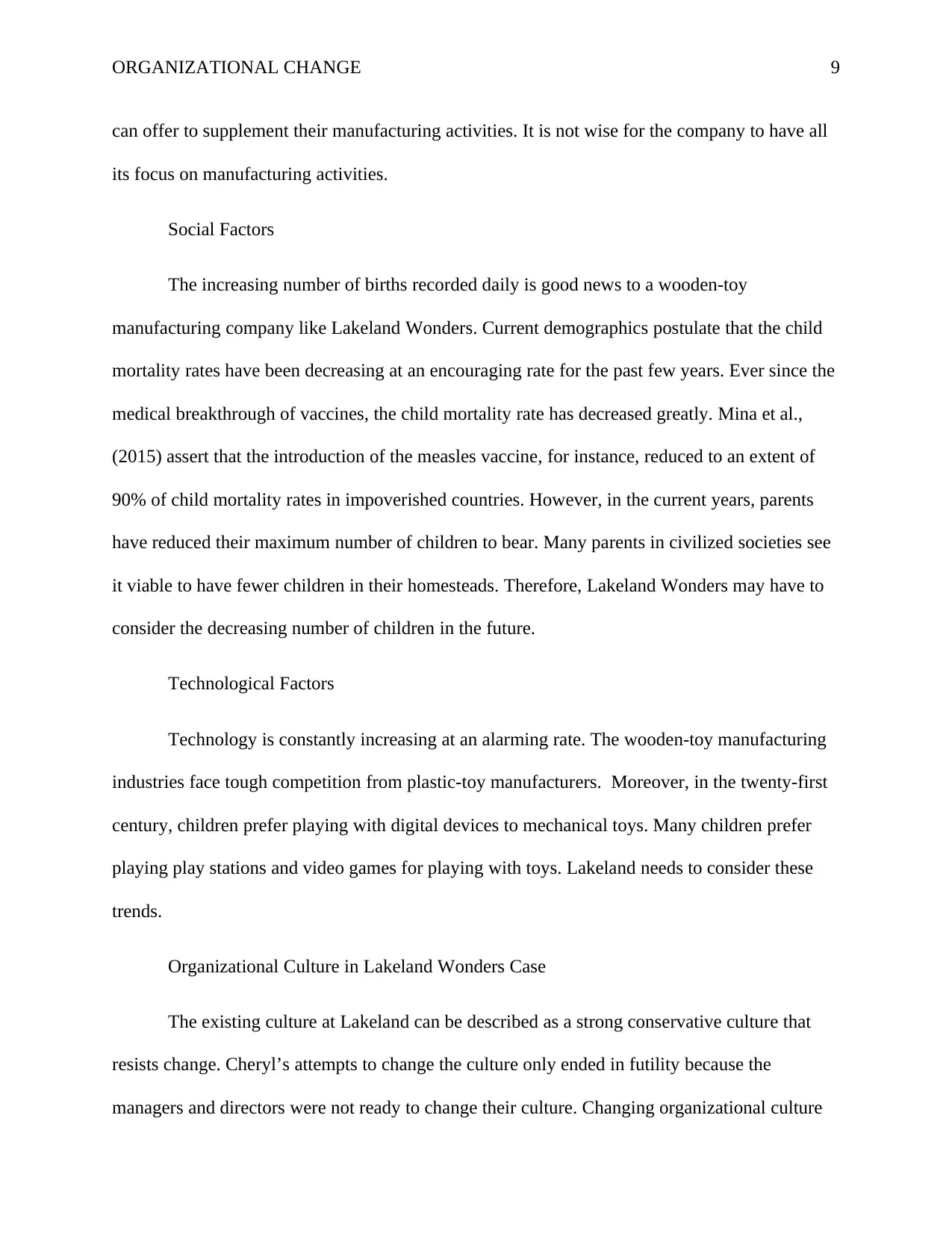
ORGANIZATIONAL CHANGE 9
can offer to supplement their manufacturing activities. It is not wise for the company to have all
its focus on manufacturing activities.
Social Factors
The increasing number of births recorded daily is good news to a wooden-toy
manufacturing company like Lakeland Wonders. Current demographics postulate that the child
mortality rates have been decreasing at an encouraging rate for the past few years. Ever since the
medical breakthrough of vaccines, the child mortality rate has decreased greatly. Mina et al.,
(2015) assert that the introduction of the measles vaccine, for instance, reduced to an extent of
90% of child mortality rates in impoverished countries. However, in the current years, parents
have reduced their maximum number of children to bear. Many parents in civilized societies see
it viable to have fewer children in their homesteads. Therefore, Lakeland Wonders may have to
consider the decreasing number of children in the future.
Technological Factors
Technology is constantly increasing at an alarming rate. The wooden-toy manufacturing
industries face tough competition from plastic-toy manufacturers. Moreover, in the twenty-first
century, children prefer playing with digital devices to mechanical toys. Many children prefer
playing play stations and video games for playing with toys. Lakeland needs to consider these
trends.
Organizational Culture in Lakeland Wonders Case
The existing culture at Lakeland can be described as a strong conservative culture that
resists change. Cheryl’s attempts to change the culture only ended in futility because the
managers and directors were not ready to change their culture. Changing organizational culture
can offer to supplement their manufacturing activities. It is not wise for the company to have all
its focus on manufacturing activities.
Social Factors
The increasing number of births recorded daily is good news to a wooden-toy
manufacturing company like Lakeland Wonders. Current demographics postulate that the child
mortality rates have been decreasing at an encouraging rate for the past few years. Ever since the
medical breakthrough of vaccines, the child mortality rate has decreased greatly. Mina et al.,
(2015) assert that the introduction of the measles vaccine, for instance, reduced to an extent of
90% of child mortality rates in impoverished countries. However, in the current years, parents
have reduced their maximum number of children to bear. Many parents in civilized societies see
it viable to have fewer children in their homesteads. Therefore, Lakeland Wonders may have to
consider the decreasing number of children in the future.
Technological Factors
Technology is constantly increasing at an alarming rate. The wooden-toy manufacturing
industries face tough competition from plastic-toy manufacturers. Moreover, in the twenty-first
century, children prefer playing with digital devices to mechanical toys. Many children prefer
playing play stations and video games for playing with toys. Lakeland needs to consider these
trends.
Organizational Culture in Lakeland Wonders Case
The existing culture at Lakeland can be described as a strong conservative culture that
resists change. Cheryl’s attempts to change the culture only ended in futility because the
managers and directors were not ready to change their culture. Changing organizational culture
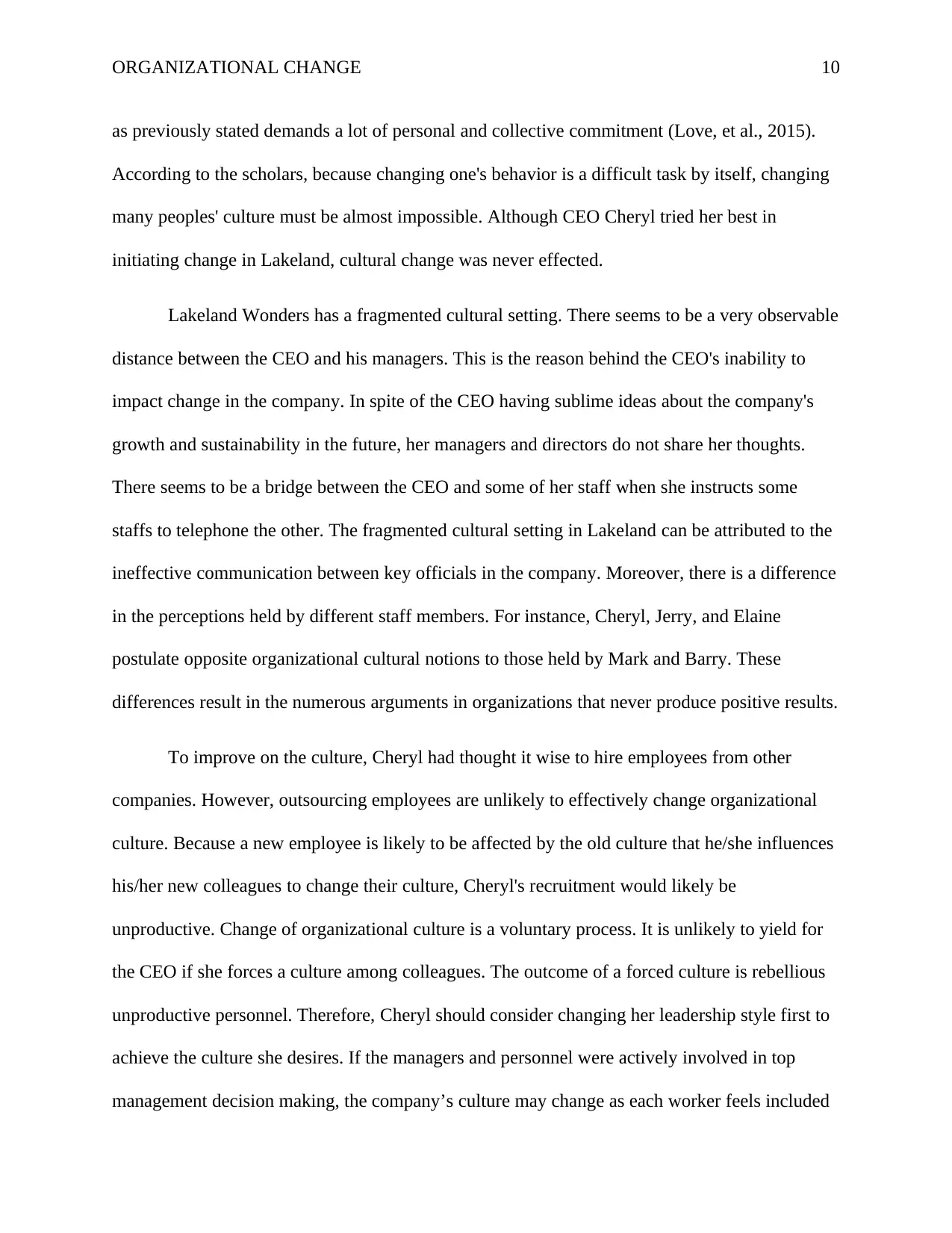
ORGANIZATIONAL CHANGE 10
as previously stated demands a lot of personal and collective commitment (Love, et al., 2015).
According to the scholars, because changing one's behavior is a difficult task by itself, changing
many peoples' culture must be almost impossible. Although CEO Cheryl tried her best in
initiating change in Lakeland, cultural change was never effected.
Lakeland Wonders has a fragmented cultural setting. There seems to be a very observable
distance between the CEO and his managers. This is the reason behind the CEO's inability to
impact change in the company. In spite of the CEO having sublime ideas about the company's
growth and sustainability in the future, her managers and directors do not share her thoughts.
There seems to be a bridge between the CEO and some of her staff when she instructs some
staffs to telephone the other. The fragmented cultural setting in Lakeland can be attributed to the
ineffective communication between key officials in the company. Moreover, there is a difference
in the perceptions held by different staff members. For instance, Cheryl, Jerry, and Elaine
postulate opposite organizational cultural notions to those held by Mark and Barry. These
differences result in the numerous arguments in organizations that never produce positive results.
To improve on the culture, Cheryl had thought it wise to hire employees from other
companies. However, outsourcing employees are unlikely to effectively change organizational
culture. Because a new employee is likely to be affected by the old culture that he/she influences
his/her new colleagues to change their culture, Cheryl's recruitment would likely be
unproductive. Change of organizational culture is a voluntary process. It is unlikely to yield for
the CEO if she forces a culture among colleagues. The outcome of a forced culture is rebellious
unproductive personnel. Therefore, Cheryl should consider changing her leadership style first to
achieve the culture she desires. If the managers and personnel were actively involved in top
management decision making, the company’s culture may change as each worker feels included
as previously stated demands a lot of personal and collective commitment (Love, et al., 2015).
According to the scholars, because changing one's behavior is a difficult task by itself, changing
many peoples' culture must be almost impossible. Although CEO Cheryl tried her best in
initiating change in Lakeland, cultural change was never effected.
Lakeland Wonders has a fragmented cultural setting. There seems to be a very observable
distance between the CEO and his managers. This is the reason behind the CEO's inability to
impact change in the company. In spite of the CEO having sublime ideas about the company's
growth and sustainability in the future, her managers and directors do not share her thoughts.
There seems to be a bridge between the CEO and some of her staff when she instructs some
staffs to telephone the other. The fragmented cultural setting in Lakeland can be attributed to the
ineffective communication between key officials in the company. Moreover, there is a difference
in the perceptions held by different staff members. For instance, Cheryl, Jerry, and Elaine
postulate opposite organizational cultural notions to those held by Mark and Barry. These
differences result in the numerous arguments in organizations that never produce positive results.
To improve on the culture, Cheryl had thought it wise to hire employees from other
companies. However, outsourcing employees are unlikely to effectively change organizational
culture. Because a new employee is likely to be affected by the old culture that he/she influences
his/her new colleagues to change their culture, Cheryl's recruitment would likely be
unproductive. Change of organizational culture is a voluntary process. It is unlikely to yield for
the CEO if she forces a culture among colleagues. The outcome of a forced culture is rebellious
unproductive personnel. Therefore, Cheryl should consider changing her leadership style first to
achieve the culture she desires. If the managers and personnel were actively involved in top
management decision making, the company’s culture may change as each worker feels included
Secure Best Marks with AI Grader
Need help grading? Try our AI Grader for instant feedback on your assignments.
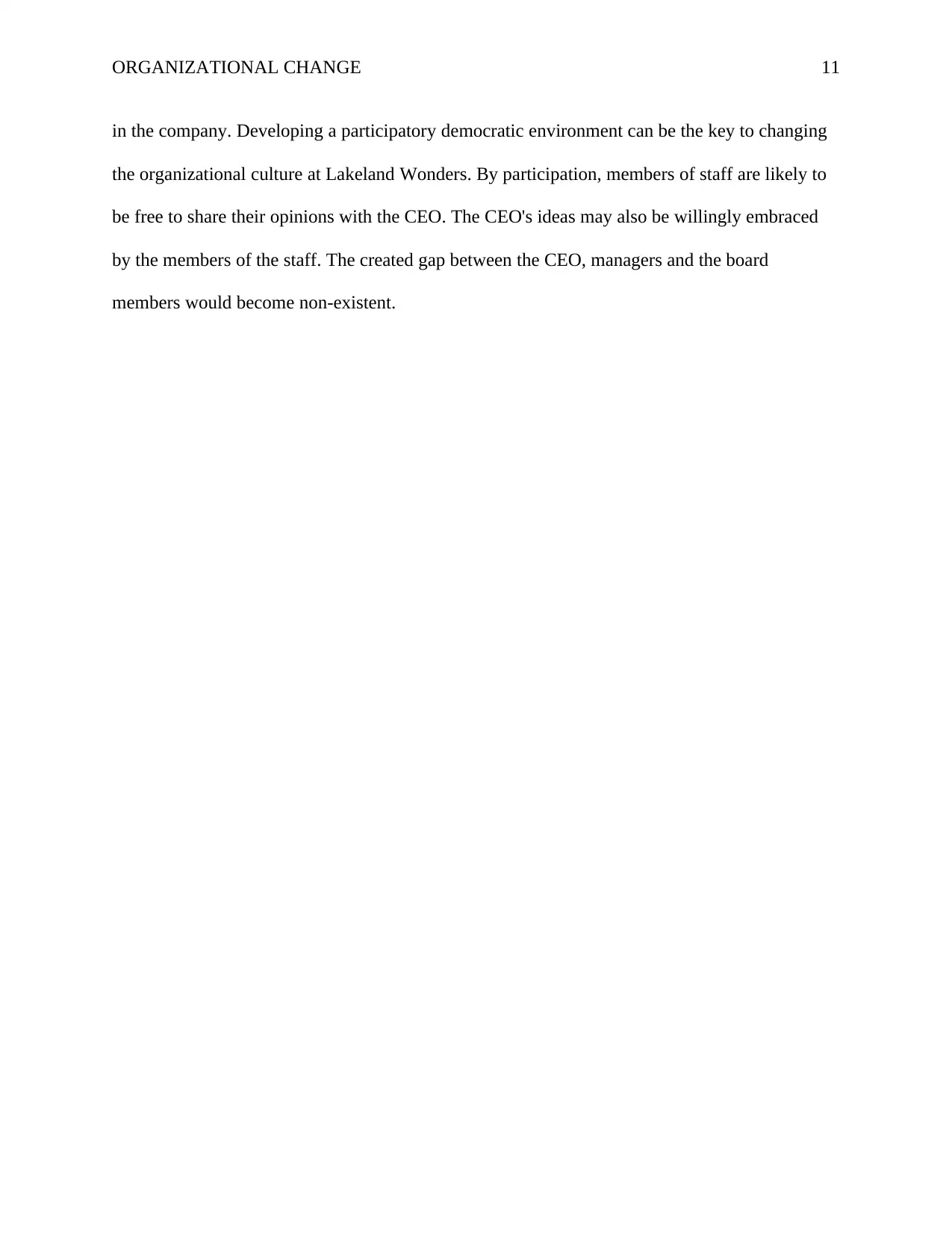
ORGANIZATIONAL CHANGE 11
in the company. Developing a participatory democratic environment can be the key to changing
the organizational culture at Lakeland Wonders. By participation, members of staff are likely to
be free to share their opinions with the CEO. The CEO's ideas may also be willingly embraced
by the members of the staff. The created gap between the CEO, managers and the board
members would become non-existent.
in the company. Developing a participatory democratic environment can be the key to changing
the organizational culture at Lakeland Wonders. By participation, members of staff are likely to
be free to share their opinions with the CEO. The CEO's ideas may also be willingly embraced
by the members of the staff. The created gap between the CEO, managers and the board
members would become non-existent.
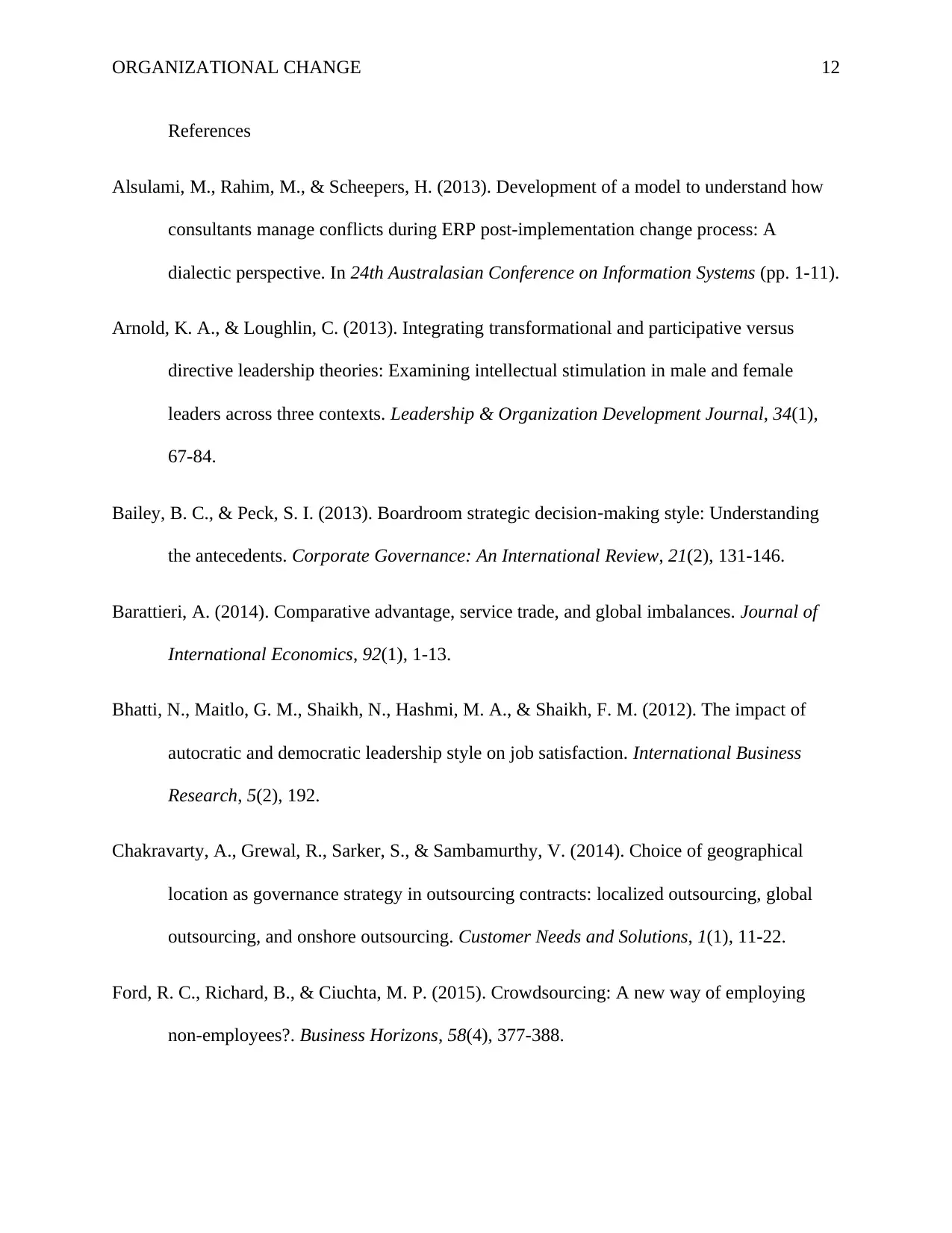
ORGANIZATIONAL CHANGE 12
References
Alsulami, M., Rahim, M., & Scheepers, H. (2013). Development of a model to understand how
consultants manage conflicts during ERP post-implementation change process: A
dialectic perspective. In 24th Australasian Conference on Information Systems (pp. 1-11).
Arnold, K. A., & Loughlin, C. (2013). Integrating transformational and participative versus
directive leadership theories: Examining intellectual stimulation in male and female
leaders across three contexts. Leadership & Organization Development Journal, 34(1),
67-84.
Bailey, B. C., & Peck, S. I. (2013). Boardroom strategic decision‐making style: Understanding
the antecedents. Corporate Governance: An International Review, 21(2), 131-146.
Barattieri, A. (2014). Comparative advantage, service trade, and global imbalances. Journal of
International Economics, 92(1), 1-13.
Bhatti, N., Maitlo, G. M., Shaikh, N., Hashmi, M. A., & Shaikh, F. M. (2012). The impact of
autocratic and democratic leadership style on job satisfaction. International Business
Research, 5(2), 192.
Chakravarty, A., Grewal, R., Sarker, S., & Sambamurthy, V. (2014). Choice of geographical
location as governance strategy in outsourcing contracts: localized outsourcing, global
outsourcing, and onshore outsourcing. Customer Needs and Solutions, 1(1), 11-22.
Ford, R. C., Richard, B., & Ciuchta, M. P. (2015). Crowdsourcing: A new way of employing
non-employees?. Business Horizons, 58(4), 377-388.
References
Alsulami, M., Rahim, M., & Scheepers, H. (2013). Development of a model to understand how
consultants manage conflicts during ERP post-implementation change process: A
dialectic perspective. In 24th Australasian Conference on Information Systems (pp. 1-11).
Arnold, K. A., & Loughlin, C. (2013). Integrating transformational and participative versus
directive leadership theories: Examining intellectual stimulation in male and female
leaders across three contexts. Leadership & Organization Development Journal, 34(1),
67-84.
Bailey, B. C., & Peck, S. I. (2013). Boardroom strategic decision‐making style: Understanding
the antecedents. Corporate Governance: An International Review, 21(2), 131-146.
Barattieri, A. (2014). Comparative advantage, service trade, and global imbalances. Journal of
International Economics, 92(1), 1-13.
Bhatti, N., Maitlo, G. M., Shaikh, N., Hashmi, M. A., & Shaikh, F. M. (2012). The impact of
autocratic and democratic leadership style on job satisfaction. International Business
Research, 5(2), 192.
Chakravarty, A., Grewal, R., Sarker, S., & Sambamurthy, V. (2014). Choice of geographical
location as governance strategy in outsourcing contracts: localized outsourcing, global
outsourcing, and onshore outsourcing. Customer Needs and Solutions, 1(1), 11-22.
Ford, R. C., Richard, B., & Ciuchta, M. P. (2015). Crowdsourcing: A new way of employing
non-employees?. Business Horizons, 58(4), 377-388.

ORGANIZATIONAL CHANGE 13
Gonzalez, R., Llopis, J., & Gasco, J. (2013). Information systems offshore outsourcing:
managerial conclusions from academic research. International Entrepreneurship and
Management Journal, 9(2), 229-259.
Jansson, N. (2013). Organizational change as practice: A critical analysis. Journal of
Organizational Change Management, 26(6), 1003-1019.
Love, P. E., Ackermann, F., Teo, P., & Morrison, J. (2015). From individual to collective
learning: A conceptual learning framework for enacting rework prevention. Journal of
construction engineering and management, 141(11), 05015009.
McNulty, E. (2002). Welcome aboard (but don't change a thing). Harvard business
review, 80(10), 32-5.
Mina, M. J., Metcalf, C. J. E., De Swart, R. L., Osterhaus, A. D. M. E., & Grenfell, B. T. (2015).
Long-term measles-induced immunomodulation increases overall childhood infectious
disease mortality. Science, 348(6235), 694-699.
Nenni, M. E., Giustiniano, L., & Pirolo, L. (2013). Demand forecasting in the fashion industry: a
review. International Journal of Engineering Business Management, 5, 37.
Putnam, L. L., Fairhurst, G. T., & Banghart, S. (2016). Contradictions, dialectics, and paradoxes
in organizations: A constitutive approach. The Academy of Management Annals, 10(1),
65-171.
Quinn, M. (2014). Stability and change in management accounting over time—A century or so
of evidence from Guinness. Management Accounting Research, 25(1), 76-92.
Gonzalez, R., Llopis, J., & Gasco, J. (2013). Information systems offshore outsourcing:
managerial conclusions from academic research. International Entrepreneurship and
Management Journal, 9(2), 229-259.
Jansson, N. (2013). Organizational change as practice: A critical analysis. Journal of
Organizational Change Management, 26(6), 1003-1019.
Love, P. E., Ackermann, F., Teo, P., & Morrison, J. (2015). From individual to collective
learning: A conceptual learning framework for enacting rework prevention. Journal of
construction engineering and management, 141(11), 05015009.
McNulty, E. (2002). Welcome aboard (but don't change a thing). Harvard business
review, 80(10), 32-5.
Mina, M. J., Metcalf, C. J. E., De Swart, R. L., Osterhaus, A. D. M. E., & Grenfell, B. T. (2015).
Long-term measles-induced immunomodulation increases overall childhood infectious
disease mortality. Science, 348(6235), 694-699.
Nenni, M. E., Giustiniano, L., & Pirolo, L. (2013). Demand forecasting in the fashion industry: a
review. International Journal of Engineering Business Management, 5, 37.
Putnam, L. L., Fairhurst, G. T., & Banghart, S. (2016). Contradictions, dialectics, and paradoxes
in organizations: A constitutive approach. The Academy of Management Annals, 10(1),
65-171.
Quinn, M. (2014). Stability and change in management accounting over time—A century or so
of evidence from Guinness. Management Accounting Research, 25(1), 76-92.
Paraphrase This Document
Need a fresh take? Get an instant paraphrase of this document with our AI Paraphraser
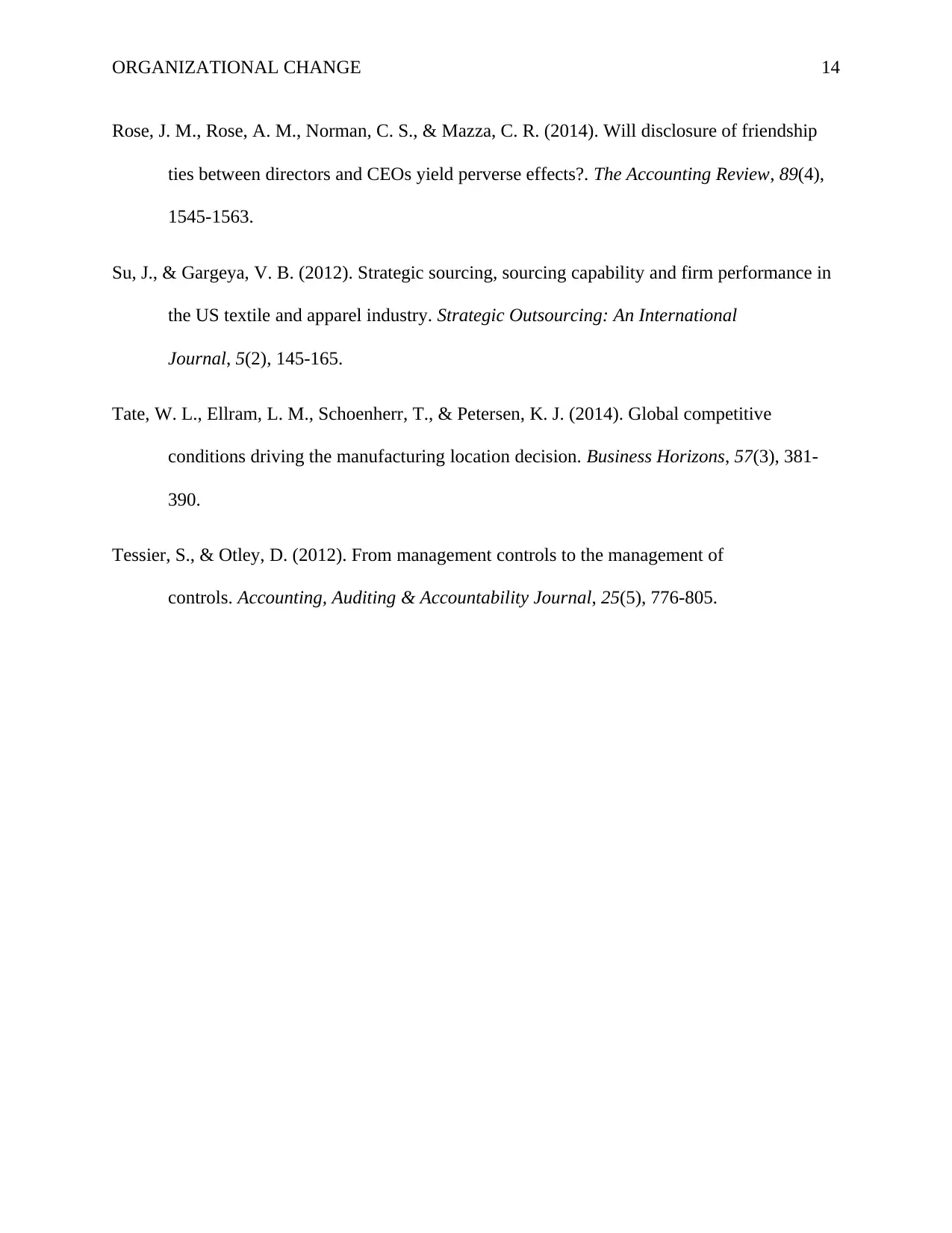
ORGANIZATIONAL CHANGE 14
Rose, J. M., Rose, A. M., Norman, C. S., & Mazza, C. R. (2014). Will disclosure of friendship
ties between directors and CEOs yield perverse effects?. The Accounting Review, 89(4),
1545-1563.
Su, J., & Gargeya, V. B. (2012). Strategic sourcing, sourcing capability and firm performance in
the US textile and apparel industry. Strategic Outsourcing: An International
Journal, 5(2), 145-165.
Tate, W. L., Ellram, L. M., Schoenherr, T., & Petersen, K. J. (2014). Global competitive
conditions driving the manufacturing location decision. Business Horizons, 57(3), 381-
390.
Tessier, S., & Otley, D. (2012). From management controls to the management of
controls. Accounting, Auditing & Accountability Journal, 25(5), 776-805.
Rose, J. M., Rose, A. M., Norman, C. S., & Mazza, C. R. (2014). Will disclosure of friendship
ties between directors and CEOs yield perverse effects?. The Accounting Review, 89(4),
1545-1563.
Su, J., & Gargeya, V. B. (2012). Strategic sourcing, sourcing capability and firm performance in
the US textile and apparel industry. Strategic Outsourcing: An International
Journal, 5(2), 145-165.
Tate, W. L., Ellram, L. M., Schoenherr, T., & Petersen, K. J. (2014). Global competitive
conditions driving the manufacturing location decision. Business Horizons, 57(3), 381-
390.
Tessier, S., & Otley, D. (2012). From management controls to the management of
controls. Accounting, Auditing & Accountability Journal, 25(5), 776-805.
1 out of 14
Related Documents
Your All-in-One AI-Powered Toolkit for Academic Success.
+13062052269
info@desklib.com
Available 24*7 on WhatsApp / Email
![[object Object]](/_next/static/media/star-bottom.7253800d.svg)
Unlock your academic potential
© 2024 | Zucol Services PVT LTD | All rights reserved.



